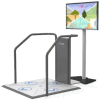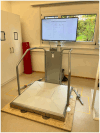Cognitive-motor exergame training on a labile surface in stroke inpatients: study protocol for a randomized controlled trial
- PMID: 38966081
- PMCID: PMC11223001
- DOI: 10.3389/fneur.2024.1402145
Cognitive-motor exergame training on a labile surface in stroke inpatients: study protocol for a randomized controlled trial
Abstract
Background: Cognitive-motor training in form of exergames has been found to be feasible and effective for the improvement of motor and cognitive functioning in older adults and several patient populations. Exergame training under unstable conditions might increase the proprioceptive resources needed and thus might be a superior training approach compared to exergame training on stable ground for stroke patients, who often have proprioceptive deficits.
Objective: Aim of this study is to assess the feasibility and effects of exergame-based cognitive-motor training on a labile platform on physical and cognitive functioning in stroke inpatients.
Methods: This is two-armed pilot randomized controlled trial taking place in an inpatient neurologic rehabilitation clinic. A total of 30 persons that are undergoing inpatient rehabilitation due to a stroke will be randomly assigned to either the intervention group (IG) or the control group (CG). Participants of the IG will receive exergame-based motor-cognitive training on a labile surface, whereas participants of the CG will train on a stable surface. Primary outcome is feasibility comprising measures of adherence, attrition, safety and usability. Secondary outcomes will be measures of cognitive (psychomotor speed, inhibition, selective attention, cognitive flexibility, brain activity) and motor (functional mobility, gait speed, balance, proprioception) functioning.
Results: Data collection started in February 2024 and is expected to be completed by August 2024.
Conclusion: This is the first study looking into exergame training on labile surface in stroke patients. It will give valuable insights into the feasibility and potential added value of this type of training and thus inform further implementation efforts in the context of inpatient rehabilitation.
Clinical trial registration: ClinicalTrials.gov, NCT06296069.
Keywords: active video games; balance; cognition; gait; neurologic patients; proprioception; rehabilitation; technology-based training.
Copyright © 2024 Büttiker, Marks, Hanke, Ludyga, Marsico, Eggimann and Giannouli.
Conflict of interest statement
The Senso-Swing prototype formally belongs to Dividat AG. Dividat AG provides the Senso-Swing free of charge for the duration of the study. Dividat AG was not involved in the study design, collection, analysis, interpretation of data, the writing of this article, or the decision to submit it for publication. The authors declare that the research was conducted in the absence of any commercial or financial relationships that could be construed as a potential conflict of interest.
Figures
Similar articles
-
PEMOCS: Evaluating the effects of a concept-guided, PErsonalised, MOtor-Cognitive exergame training on cognitive functions and gait in chronic Stroke-study protocol for a randomised controlled trial.Trials. 2024 Jul 4;25(1):451. doi: 10.1186/s13063-024-08283-7. Trials. 2024. PMID: 38965612 Free PMC article.
-
Feasibility of Cognitive-Motor Exergames in Geriatric Inpatient Rehabilitation: A Pilot Randomized Controlled Study.Front Aging Neurosci. 2021 Nov 29;13:739948. doi: 10.3389/fnagi.2021.739948. eCollection 2021. Front Aging Neurosci. 2021. PMID: 34912206 Free PMC article.
-
Feasibility and Effectiveness of a Personalized Home-Based Motor-Cognitive Training Program in Community-Dwelling Older Adults: Protocol for a Pragmatic Pilot Randomized Controlled Trial.JMIR Res Protoc. 2023 Nov 9;12:e49377. doi: 10.2196/49377. JMIR Res Protoc. 2023. PMID: 37943591 Free PMC article.
-
Effectiveness of an Individualized Exergame-Based Motor-Cognitive Training Concept Targeted to Improve Cognitive Functioning in Older Adults With Mild Neurocognitive Disorder: Study Protocol for a Randomized Controlled Trial.JMIR Res Protoc. 2023 Feb 6;12:e41173. doi: 10.2196/41173. JMIR Res Protoc. 2023. PMID: 36745483 Free PMC article.
-
Optimization of Upper Extremity Rehabilitation by Combining Telerehabilitation With an Exergame in People With Chronic Stroke: Protocol for a Mixed Methods Study.JMIR Res Protoc. 2020 May 21;9(5):e14629. doi: 10.2196/14629. JMIR Res Protoc. 2020. PMID: 32097119 Free PMC article.
References
-
- Feigin VL, Stark BA, Johnson CO, Roth GA, Bisignano C, Abady GG, et al. . Global, regional, and national burden of stroke and its risk factors, 1990-2019: a systematic analysis for the global burden of disease study 2019. Lancet Neurol. (2021) 20:795–820. doi: 10.1016/S1474-4422(21)00252-0 - DOI - PMC - PubMed
-
- El Husseini N, Katzan IL, Rost NS, Blake ML, Byun E, Pendlebury ST, et al. . Cognitive impairment after ischemic and hemorrhagic stroke: a scientific statement from the American Heart Association/American Stroke Association. Stroke. (2023) 54:E272–91. doi: 10.1161/STR.0000000000000430, PMID: - DOI - PubMed
Associated data
LinkOut - more resources
Full Text Sources
Medical







